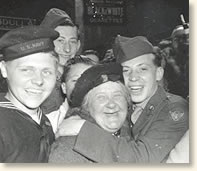|

Victory celebration, Piccadilly Circus
London May 7, 1945
|
On April 30, 1945, as Russian troops fought to within yards of his subterranean bunker, Adolph Hitler put a pistol to his head, pulled the trigger and closed the curtain on the Third Reich. Before his death, Hitler anointed Admiral Karl Donitz as his successor with orders to continue the fighting. Hitler was unaware that the German surrender had already begun.
On the day before his death all German troops in Italy laid down their arms. On May 4, German forces in Holland, Denmark and northwest Germany surrendered to British Field Marshall Montgomery. On May 6, Donitz authorized General Alfred Jodl to "conclude an armistice agreement" with General Eisenhower. The Germans wanted a separate peace with the allied troops in the West in order to continue their battle with the Russians in the East. Eisenhower would have none of it. He ordered the Germans to surrender unconditionally the next day. The Germans acquiesced, signing the surrender document on May 7, in the French city of Reims. The cessation of fighting took effect at 11:01 PM on May 8. The Russians insisted that a separate signing take place in Berlin on May 9. After six catastrophic years, the war in Europe was over.
References: Blond, G., The Death of Hitler's Germany (1954); Toland, John, The last Hundred Days (1966).
|






